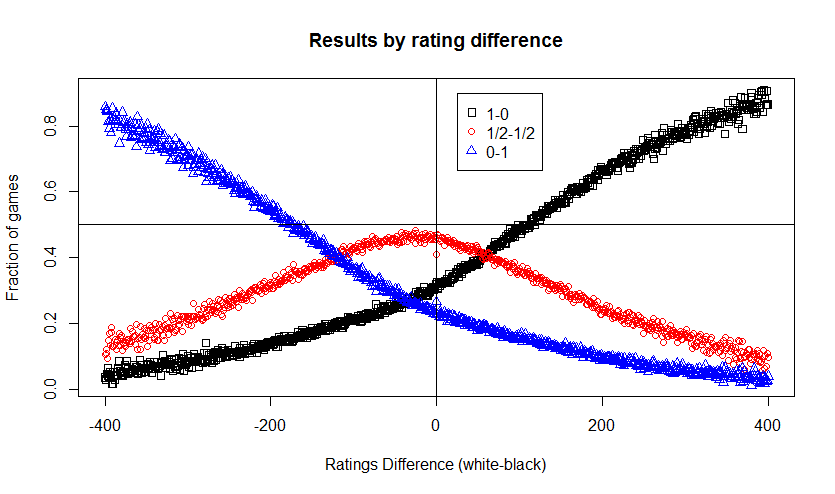The Elo Rating System
Competitive chess players, at the amateur club level all the way through the top grandmasters, receive ratings based on their performance in games. The ratings formula in use since 1960 is based on a model first proposed by the Hungarian-American physicist Arpad Elo. It uses a logistic equation to estimate the probability of a player winning as a function of that player’s rating advantage over his opponent:
$latex E = \frac 1 {1 + 10^{-\Delta R/400}}&s=3$
So for example, if you play an opponent who out-rates you by 200 points then your chances of winning are only 24%.
After each tournament, game results are fed back to a national or international rating agency and the ratings adjusted. If you scored better than expected against the level of opposition played your rating goes up. If you did worse it goes down. Winning against an opponent much weaker than you will lift your rating little. Defeating a higher-rated opponent will raise your rating more.
That’s the basics of the Elo rating system, in its pure form. In practice it is slightly modified, with ratings floors, bootstrapping new unrated players, etc. But that is its essence.
Measuring the First Mover Advantage
It has long been known that the player that moves first, conventionally called “white”, has a slight advantage, due to their ability to develop their pieces faster and their greater ability to coax the opening phase of the game toward a system that they prefer.
So how can we show this advantage using a lot of data?
I started with a Chessbase database of 1,687,282 chess games, played from 2000-2013. All games had a minimum rating of 2000 (a good club player). I excluded all computer games. I also excluded 0 or 1 move games, which usually indicate a default (a player not showing up for an assigned game) or a bye. I exported the games to PGN format and extracted the metadata for each game to a CSV file via a python script. Additional processing was then done in R.
Looking at the distribution of ratings differences (white Elo-black Elo) we get this. Two oddities to note. First note the excess of games with a ratings difference of exactly zero. I’m not sure what caused that, but since only 0.3% of games had this property, I ignored it. Also there is clearly a “fringe” of excess counts for ratings that are exactly multiples of 5. This suggests some quantization effect in some of the ratings, but should not harm the following analysis.
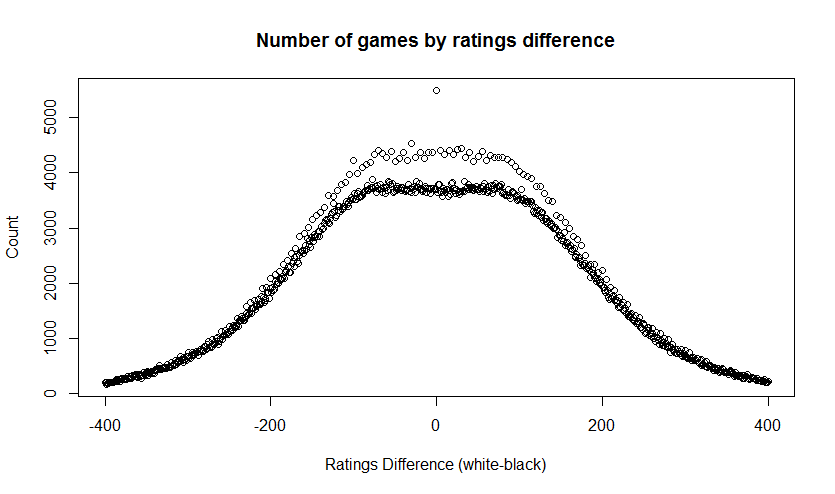
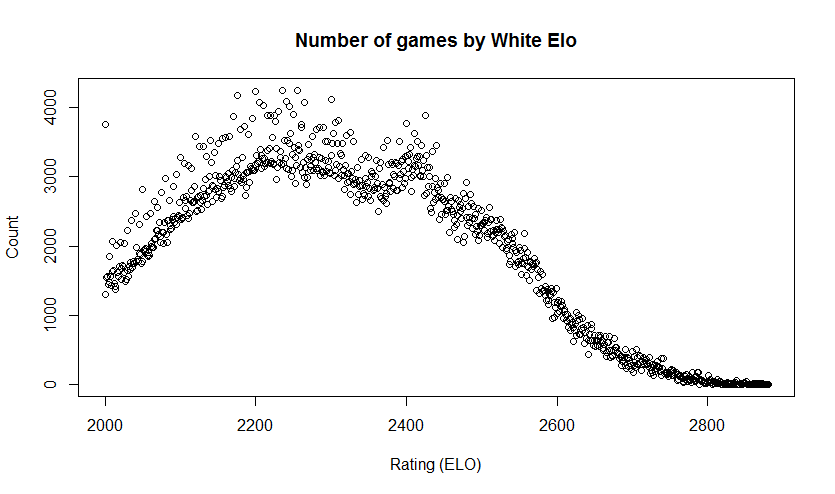
The collection has results of:
- 1-0 (36.4%)
- 1/2-1/2 (35.5%)
- 0-1 (28.1%)
So the overall score, from white’s perspective was 54.2% (counting a win as 1 point and a draw as 0.5 points).
So white as a 4.2% first move advantage, yes? Not so fast. A look at the average ratings in the games shows:
- mean white Elo: 2312
- mean black Elo: 2309
So on average white was slightly higher rated than black in these games. A t-test indicated that the difference in means was significant to the 95% confidence level. So we’ll need to do some more work to tease out the actual advantage for white.
Looking for a Performance Advantage
I took the data and binned it by ratings difference, from -400 to 400, and for each difference I calculated the expected score, per the Elo formula, and the average actual score in games played with that ratings difference. The following chart shows the black circles for the actual scores and a red line for the predicted score. Again, this is from white’s perspective. Clearly the actual score is above the expected score for most of the range. In fact white appears evenly matched even when playing against an opponent 35-points higher.
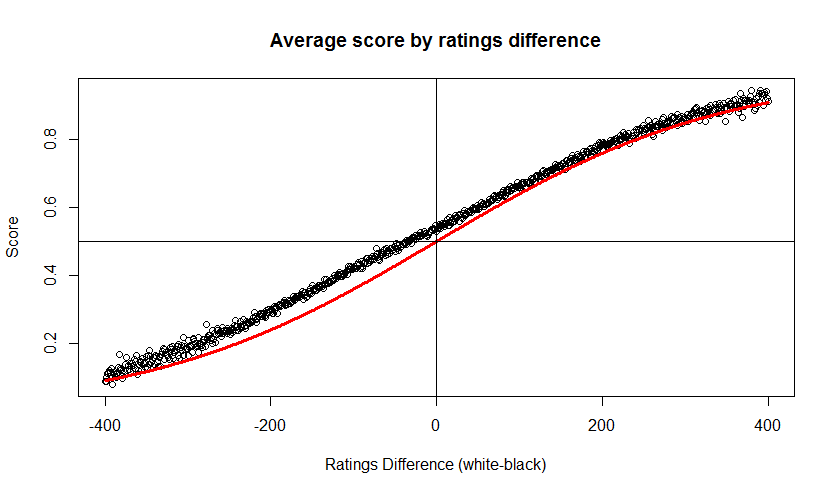
The trend is a bit clearer of we look at the “excess score”, the amount by which white’s results exceed the expected results. In the following chart the average excess score is indicated by a dotted line at y=0.034. So the average performance advantage for white, accounting for the strength of opposition, was around 3.4%. But note how the advantage is strongest where white is playing a slightly stronger player.
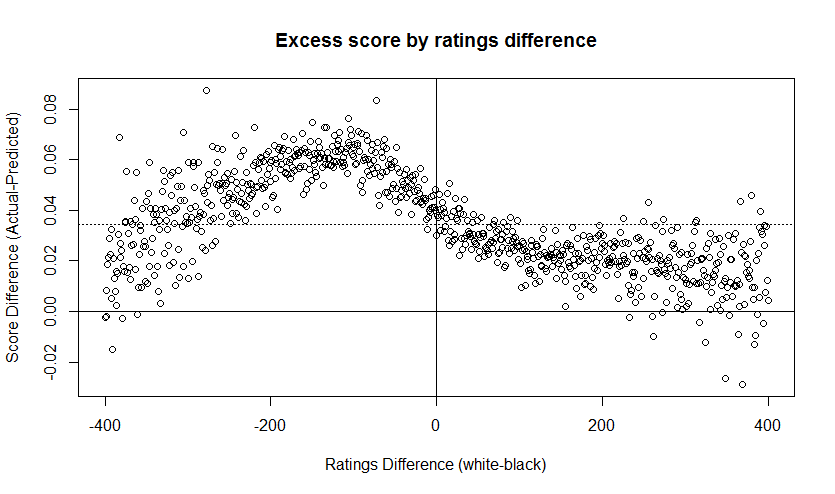
Finally I looked at the actual game results, the distribution of wins, draws and losses, by ratings differences. The Elo formula doesn’t speak to this. It deals with expected scores. But in the real world one cannot score 0.8 in a game. There are only three options: win, draw or lose. In this chart you see the first mover advantage in another way. The entire range of outcomes is essentially shifted over to the left by 35 points.
